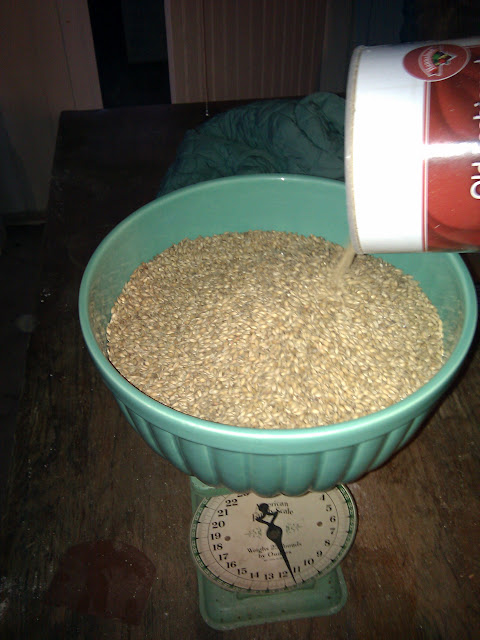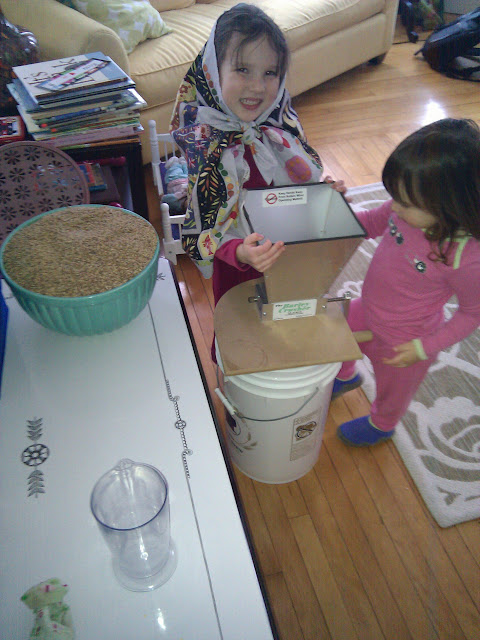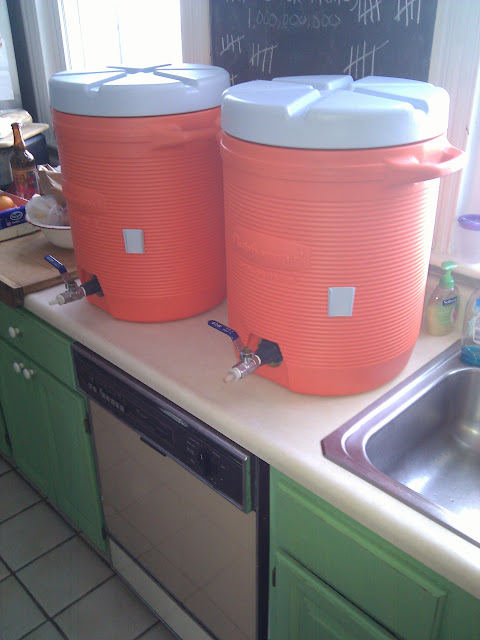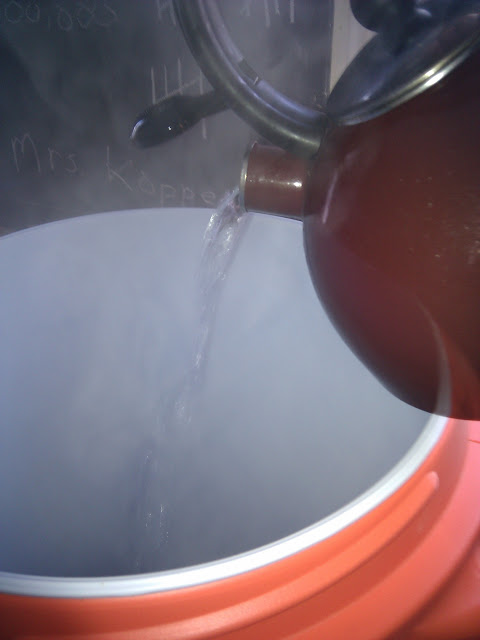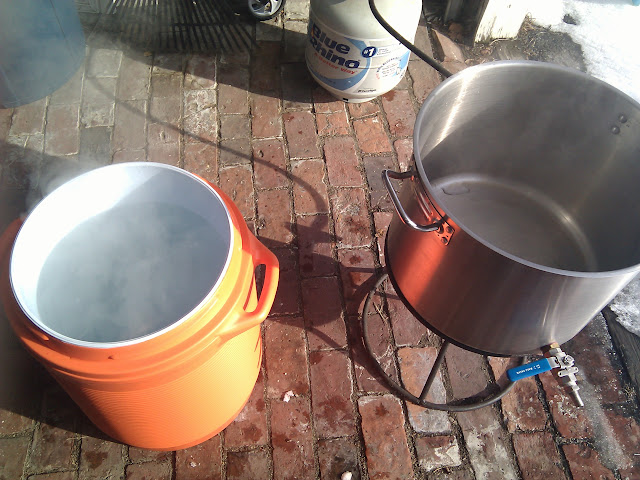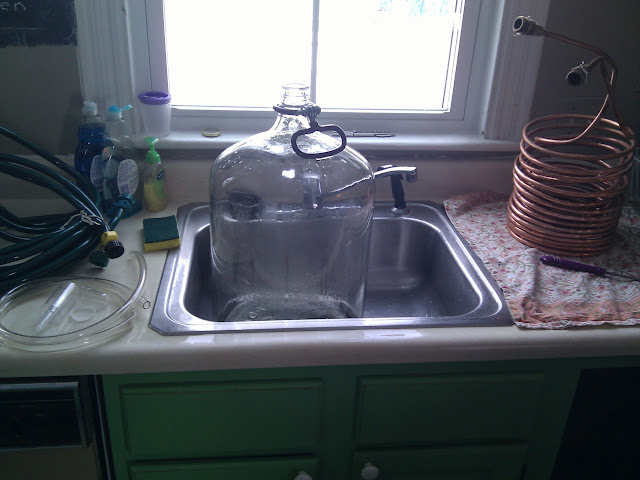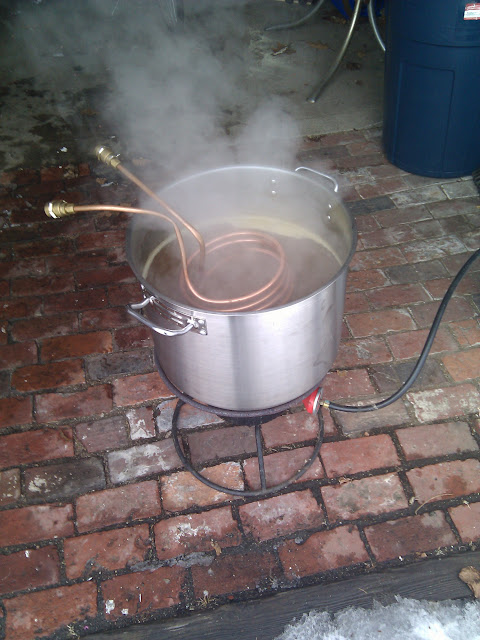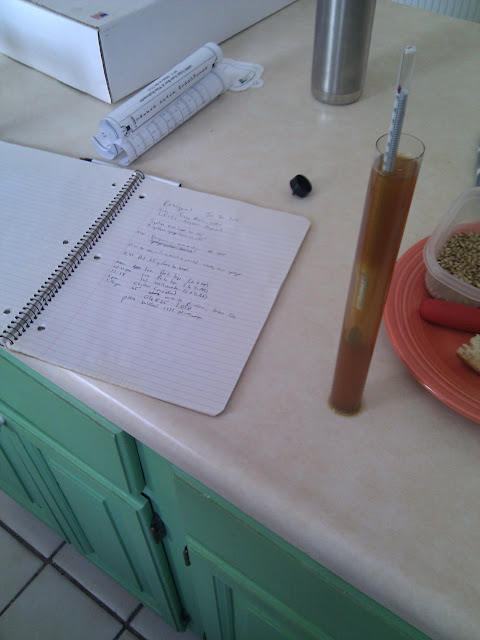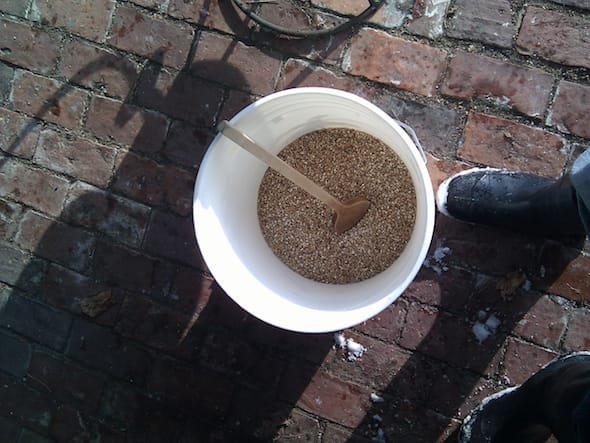
Here's a picture/video diary of last week's brew day. It's the first time I've brewed in about a year, owing to school. It was relaxing and fun and I mean to do it a lot more this year.
Weighing out the grains the day before. I wasn't working from a recipe. I usually don't. I have a considerable grain store in the basement. So, I just head down there and grab what strikes my fancy. I like a simple, hoppy beer for my daily ration. That means a very high quality base malt and not much else in the grain bill. This time I grabbed eight or nine pounds of Crisp Maris Otter and just a pound or so of a lighter crystal malt.
Crushing the grain manually. So far I've resisted the impulse to gearify this process. A little manual labor is not a bad thing for sedentary-software-developer types. Eventually I'll motorize.
Rosa sports traditional mesopotamian brewing garments. Just kidding. That's just how five year olds dress.
Prepping the mash and lauter tuns. Converted 10 gallon drink coolers. They hold the temp of the hot liquor and the mash reasonably well for an hour or more. Cleaning things up is the great brew day time suck.
The mash tun is outfitted with a stainless steel false bottom. This holds the grains back when I run hot water through the tun to extract the sugars (sparging).
I heat up both tuns with some hot water. Otherwise they'll steal a few degrees each from the mash and hot liquor.
The pristine and well-appointed brewery.
Doughing-in. A good stir to avoid those dreaded "dough balls." There is a lot of science in the mash. A lot of things to fiddle with, especially temperature. The long and short is that if you let the grains sit for an hour or more in water at about 150 degrees, the starches in the malted grain will be converted into sugar (food for the yeast). You can do a simple iodine test to ensure that this conversion has happened. I haven't done that in years.
One of the great things about brewing beer is that you get to say cool things. This is not just hot water in a bucket, it's hot liquor...180 degrees fahrenheit or so. Technically, I'd advise twice the volume of the water used in the mash. In practice, I just fill up the cooler, more or less.
The revolving stainless steel sparge arm. This is a handy, but by no means necessary, brew day tool. For a couple years at the outset of all-grain brewing, I manually dribbled the water over the grains with a saucepan. It was a labor of love...and a testament to the fact that you can do all-grain brewing with near-zero investment in special equipment. The sparge arm allows me to walk away from the sparge and play with the kids, get another beer, etc. The idea of the sparge is to gently sprinkle water over the grains so that the water runs evenly through, pulling as much sugar out as possible.
At the beginning of the sparge I capture the first, grainy runnings in a small vessel and add them back on top of the grains. Sparging is a big source of anxiety for the new all-grain brewer. But, it's really much ado about nothing. I don't recirculate much. Grain in the wort settles out in the boil. A stuck sparge is nothing to sweat. I've come back to the sparge to find it stuck more than once. A nudge here, an adjustment there. As long as your hot liquor is trickling onto the grains at more or less the same rate that it's trickling out of the lauter tun, and as long as your grains are submerged in water, you're set.
The unattended sparge. Notice the sophisticated insulation equipment (a beach towel) minimizing heat loss.
Sparge over, the wort goes on the heat for the boil. I keep the lid on until the boil gets going. Then it's off with the lid for a long, vigorous boil. One hour...ninety minutes. It depends on how the kids are behaving.
The moment the wort comes to a boil is exciting. The sweet wort steam smells great. A little care is required here to avoid a messy boil over. If you're worried about it, just keep a spray bottle of cold water on hand to knock down a runaway boil. Bittering hops go in early for the long haul. Flavoring hops in the middle of the boil. Some aroma hops at the very end. I try to always have whole leaf hops on hand to throw into the secondary fermenter. There is nothing like dry hopping to make a beer bright and lively.
More cleaning. The seven gallon primary fermenter needs cleaning while the boil continues.
The wort chiller. This is the one other brew tool that is indispensable. I can recall some fairly idiotic and ineffective attempts to chill wort without one way back when I started. There is simply no way to get wort down to a pitchable temperature quickly without one. The easiest way to sanitize the wort chiller is to drop it in the boil for the last ten minutes. That's a homemade chiller that, I think, cost me about 10 bucks to make back when I worked at a hardware distributor and copper was relatively inexpensive.
A picture of order and efficiency! I realized at the last minute that I was not going to be able to run the water from the outside spigot because...well...it's winter. So I lugged the 5 gallons of hot wort into the house (not recommended) to chill it.
After putting the wort into the primary and pitching the yeast. I took an original gravity reading (for the purpose of calculating the alcohol content after fermentation). This beer turned out to be a big one...weighing in at 1.058. Which means it's going to take a lot longer to condition before drinking. I even took some (meager) notes! I'm not always very diligent about note-taking. I went an entire year of brewing without doing that...and without ever taking any gravity readings.
I'm a bit of an odd duck about my brewing philosophy. I don't believe in brewing to styles (IPA, barley wine, etc.). I prefer to brew to senses (taste, smell, mouth feel, etc.). I'm also not a big fan of repeatability. I like the variation and surprise that comes with whimsical, haphazard brewing. That's the allure of homebrewing for me in a nutshell right there. You can make whatever the hell you want. You can be original. If things go awry? Who cares. I've never made a mistake that I didn't enjoy.
Outside of drinking the beer, this is the big payoff. Fermentation is beautiful. Yeast life is teeming in there. Alcohol is in the offing. The smells in the house are invigorating: sweet malt and grassy hop and bready yeast.
I know I wasn't super precise about the process. That was on purpose. It's best to fumble a bit and learn by your mistakes. But, if anything above confounds you or if you want more specific info, just drop me a question by email.
